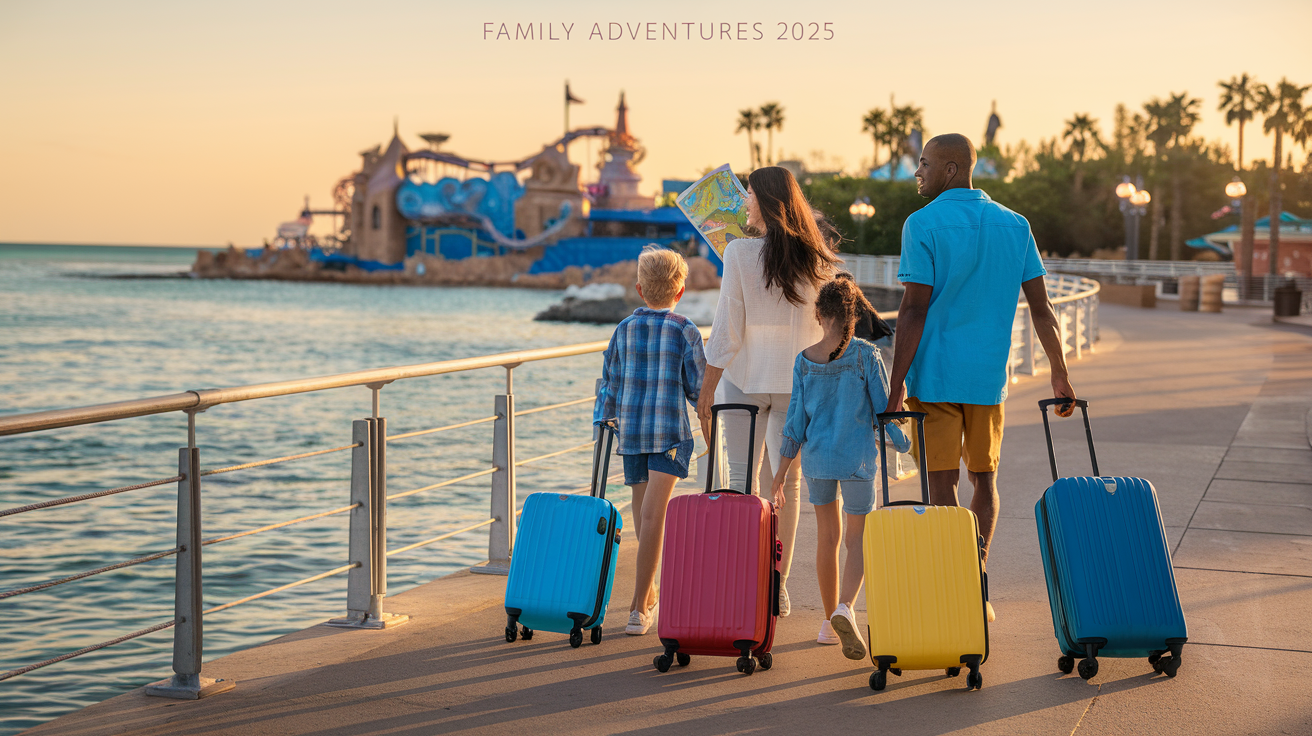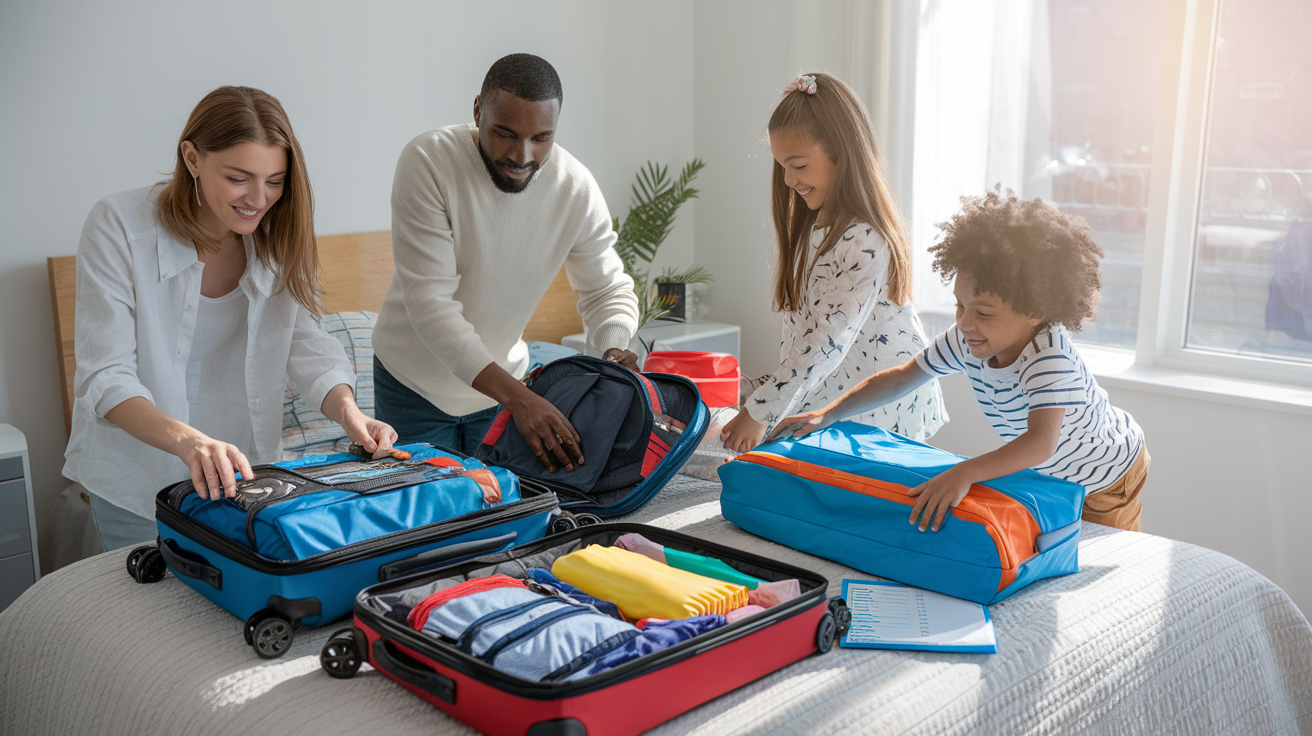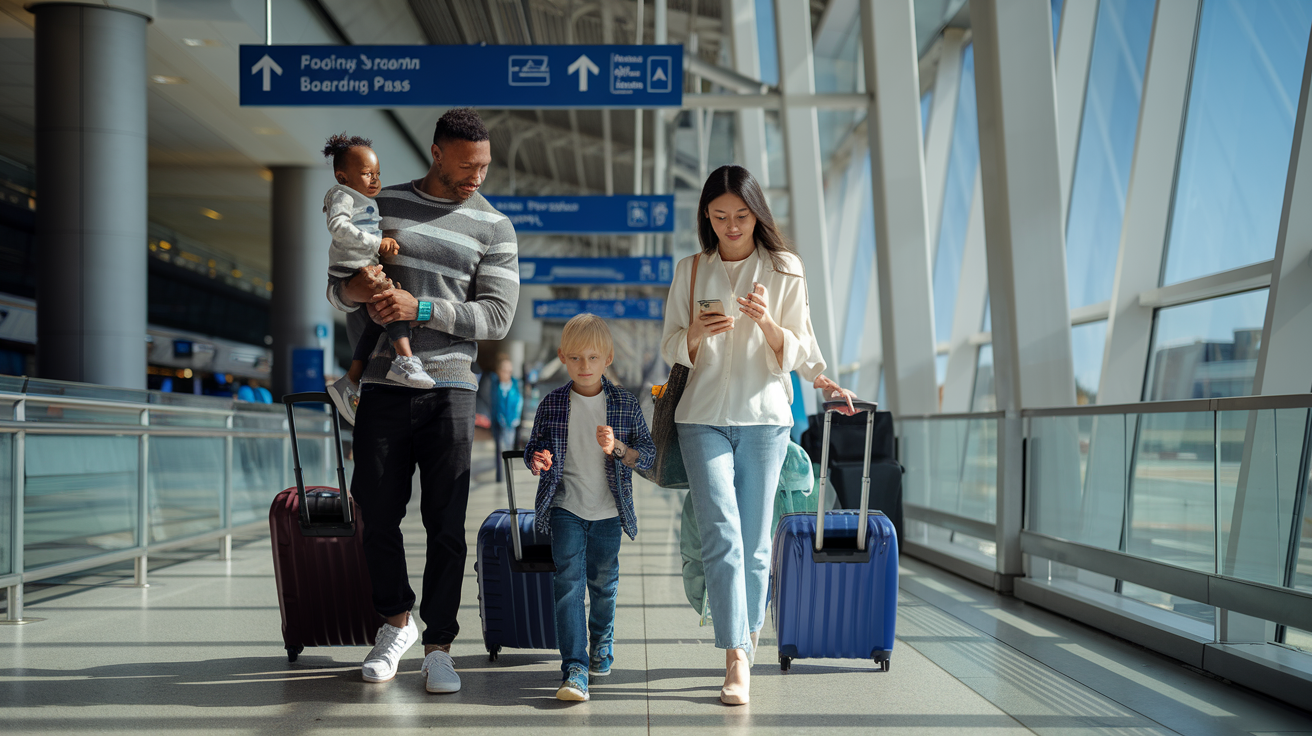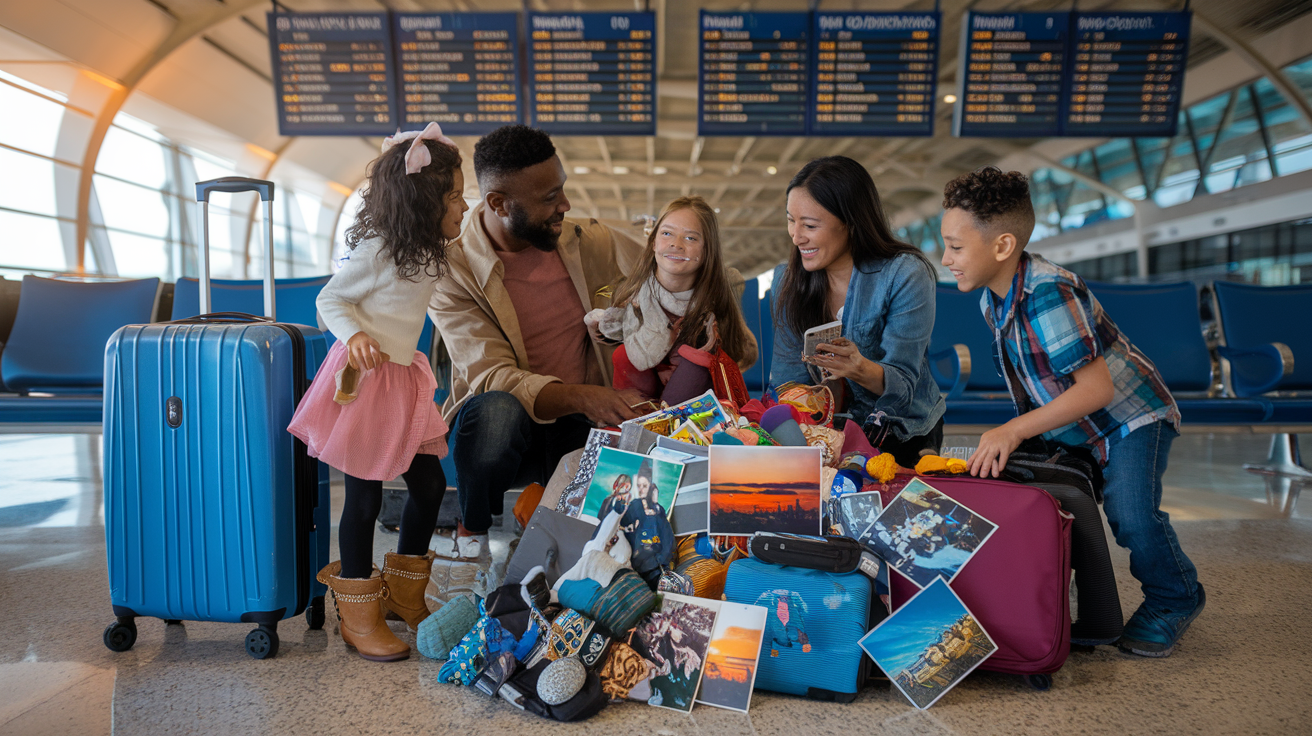Physical Address
30 N Gould St Ste N Sheridan, WY 82801
Physical Address
30 N Gould St Ste N Sheridan, WY 82801


Ever stood in the middle of an airport with two overtired kids, jet-lagged spouse, and thought, “Why didn’t we just stay home?” Been there. Done that. Got the souvenir meltdown to prove it.
But family travel doesn’t have to feel like herding cats through customs. The right destinations make all the difference.
In this guide, I’ll walk you through the absolute best destinations for family travel in 2025, with insider tips that actually work when you’ve got small humans in tow. These aren’t just places with a kid’s menu and a pool – they’re memory-makers that both parents and children genuinely enjoy.
What’s changed this year? Well, that’s where things get interesting…

The theme park scene in 2025 is absolutely explosive! If your kids have been begging for thrill rides and magical experiences, this is THE year to make those dreams happen.
Disney’s just unveiled their “Cosmic Frontier” expansion at Magic Kingdom – the first-ever space exploration themed area with zero-gravity simulators that’ll have your 7-year-old floating (safely!) through an asteroid field. My nephew couldn’t stop talking about it for weeks.
Universal Studios has finally opened their long-awaited “Fantastic Beasts” immersive land. Think Wizarding World but with more interactive elements where kids can actually “cast spells” that trigger real effects throughout the park. The wait times are crazy, but totally worth it – just grab their new FastPass+ Ultra option before they sell out.
For families with younger kids, LEGOLAND’s new “Ocean Explorers” section is perfect. They’ve built this incredible submarine ride where the seats actually move in sync with the 4D experience. And yes, there are splash zones, so pack extra clothes!
Here’s what’s hot at the major parks:
| Park | New Attraction | Best For Ages |
|---|---|---|
| Disney World | Cosmic Frontier | 6-13 |
| Universal | Fantastic Beasts Land | 8+ |
| LEGOLAND | Ocean Explorers | 3-10 |
| Six Flags | Mega Coaster Challenge | 10+ |
Pro tip: Most of these new attractions offer “parent swap” options so both adults can enjoy the ride without waiting in line twice. Just ask at the entrance.
Beach vacations have evolved way beyond just building sandcastles (though that’s still awesome).
Maui’s Ka’anapali Beach has introduced guided “Reef Explorer” programs where kids get special underwater viewing devices to spot tropical fish without needing to fully snorkel. The marine biologists running these programs are amazing with children, turning every colorful fish into an exciting discovery.
Cancun has completely reimagined its family appeal with the new “Maya Kids Adventure” packages. These include shallow-water cenote visits specifically designed for children to learn about ancient Maya culture while splashing around in crystal-clear waters.
San Diego’s Coronado Beach launched their “Junior Lifeguard Experience” where kids 5-12 get a 2-hour mini-training with real lifeguards, learning water safety while having a blast with rescue boards and beach games. My kids still wear their certificates around the house!
For something truly unique, check out Denmark’s Lalandia Beach, where they’ve created a heated indoor/outdoor beach experience that’s perfect no matter the weather. They’ve added these incredible floating obstacle courses that are basically “Wipeout” for kids.
Gone are the days when “cultural travel” meant dragging bored kids through endless museums.
Kyoto’s new Family Cultural Path features interactive stations where kids can practice traditional Japanese arts like origami, taiko drumming, and calligraphy. Each activity only takes 15-20 minutes – perfect for short attention spans!
Rome has finally caught up with family needs by introducing “Gladiator School for Families” where kids AND parents learn basic combat moves with foam swords, get dressed in tunics, and learn about ancient Roman life through play. The instructors stay completely in character, which had our whole family laughing.
The new Children’s Museum of History in Washington DC uses incredible holographic technology to let kids “meet” historical figures who answer their questions in real-time. My daughter had a 5-minute conversation with “Amelia Earhart” and was completely mesmerized.
This year’s standout is Costa Rica’s new “Junior Ranger” overnight programs in Monteverde Cloud Forest. Kids sleep in specially designed eco-pods with transparent domes to see nocturnal animals, while guides help them spot sloths, toucans and howler monkeys.
South Africa’s family safari options have gotten much more accessible with “Mini Jeep” excursions where kids can drive their own (supervised!) small electric vehicles alongside the main safari jeep. They get special kid-friendly binoculars and wildlife spotting guides.
Closer to home, Yellowstone’s new “Wolf Tracker” family programs let kids use real tracking technology to follow wolf packs remotely, with rangers explaining pack behavior at a level children actually understand and enjoy.
National Parks remain the ultimate budget win in 2025, especially with the new “Fourth Grader Free” program that gives entire families free entry when traveling with a 9-10 year old. The Junior Ranger programs keep getting better, with digital components that extend the learning after you leave.
All-inclusive resorts in Mexico and the Dominican Republic have created new “Family Value Weeks” during shoulder seasons (late April-early June and September-October) with kids-stay-free deals AND included excursions that previously cost extra.
Portugal’s Algarve region has become the budget-conscious family’s European dream, with affordable vacation apartments and free beach activities sponsored by local tourism boards. The new municipal adventure parks offer zip-lines and climbing walls at a fraction of commercial prices.
Cruise lines have introduced “Kids Solo Free” promotions where children can share cabins without adults paying for a third/fourth person supplement – a game-changer for single parents or families with multiple children.

Gone are the days when booking six months ahead was your best bet. The travel landscape has completely flipped in 2025.
For summer destinations, you’ll find the sweet spot is now 8-10 months in advance, especially for popular spots like Disney or major European cities. Wait any longer and you’re fighting for scraps or paying premium prices that’ll make your wallet weep.
But here’s the insider tip that most families miss: shoulder season bookings (May and September) have new “flash windows” about 3-4 months out when airlines and hotels release unsold inventory. I’ve seen family suites at 40% off during these windows!
Winter holiday travel? Lock it down 11 months ahead minimum. Those Christmas markets in Germany and ski resorts in Colorado don’t wait for procrastinators anymore.
For spring break, contrary to what you might think, booking just 2-3 months ahead often scores better deals than early birds, as resorts get nervous about filling rooms.
The 2025 booking rule of thumb:
The biggest family vacation killer? Choosing places your kids aren’t ready for. Trust me, dragging a toddler through an art museum is torture for everyone involved.
For babies and toddlers (0-4), prioritize destinations with:
Lake resorts and beach destinations with shallow waters work beautifully here. My 3-year-old was thrilled with a simple cabin at Lake Tahoe for a week.
Elementary kids (5-9) thrive with:
This is prime time for national parks, working farms, and destinations with hands-on museums.
Tweens and teens (10-17) need:
Urban destinations and adventure-focused resorts hit the sweet spot for this age group.
Three generations traveling together is the fastest growing segment in family travel for 2025. But without proper planning, it can quickly devolve into chaos.
First, establish clear financial boundaries upfront. Who’s paying for what? Awkward conversations before the trip beat tension during it. Many families now use shared digital spreadsheets to track expenses.
Accommodation is make-or-break. Skip hotels and opt for vacation rentals with:
The scheduling secret? Alternate between full-group activities and split sessions. Maybe grandparents take the kids for a morning while parents enjoy adult time, then switch.
Transportation deserves special attention. Renting multiple vehicles often works better than trying to cram everyone into one van. The flexibility is worth the extra cost.
The rigid, packed schedules of past family vacations? Dead and buried in 2025. Flexibility is king now.
Start with the 2:1 ratio rule – for every two planned activities, leave one block of time completely unscheduled. This breathing room allows for unexpected discoveries, much-needed rest, or splitting up based on energy levels.
Morning people and night owls in your crew? Establish core hours (typically 11am-4pm) when everyone commits to being together, then let early risers and night owls do their thing outside those times.
Create a “wish list” rather than a fixed itinerary. Have each family member identify their top three must-do activities. Guarantee everyone gets their #1 pick, then work the others in as time and energy permit.
Weather backup plans are non-negotiable. For every outdoor activity, have an indoor alternative ready to go. Beach day rained out? Quick pivot to that indoor water park or museum.
Most importantly, build in recovery days after travel days. Nothing ruins a trip faster than dragging jet-lagged kids through activities they’re too tired to enjoy.

Ever tried packing for a family vacation and ended up with suitcases so heavy you needed a forklift? Been there! The secret to stress-free family travel in 2025 isn’t bringing everything but the kitchen sink—it’s packing smart.
Start with clothing basics: the 5-5-3 rule works wonders. That’s five tops, five bottoms, three pairs of shoes per person. Mix and match is the name of the game. Quick-dry fabrics are a godsend—wash them in the sink at night, and they’re ready by morning.
For babies and toddlers, ditch the bulky stroller for a lightweight travel version. The 2025 models fold to backpack size but still offer decent storage. Compression packing cubes have become family travel MVPs—they organize clothes and reduce volume by up to 40%.
Consider these multi-purpose winners:
Remember, most destinations have stores. You can buy diapers, wipes, and snacks on arrival rather than lugging them across continents.
The family travel tech scene has exploded in 2025, with tools that genuinely make life easier, not just add digital clutter.
The must-have family travel apps this year:
Portable power has finally caught up with our needs. The new solar-charging battery packs weigh less than a small water bottle but can charge multiple devices for days.
Noise-canceling headphones for kids are now actually comfortable enough that children will wear them on flights. The FlySleepy models even have bedtime story options built in.
Digital entertainment prep saves sanity. Download movies, games, and books before leaving. Pro tip: set up a shared family cloud folder with everyone’s entertainment so you’re not stuck watching Peppa Pig when your tablet dies.
Nothing ruins a family trip faster than a sick kid and no medicine. Your travel medical kit doesn’t need to be massive, but it should be mighty.
Pack these non-negotiables:
The 2025 travel pharmacies have stepped up their game with kid-friendly options. The Tiny Travelers Med Kit includes medicine dispensers disguised as toys and wound cleaning that doesn’t sting.
Always bring copies of prescriptions and a note from your doctor for any regular medications. Healthcare apps like DocConnect now offer 24/7 pediatric consultations in most countries, often covered by travel insurance.
Speaking of insurance, the family travel policies have improved dramatically. Many now cover minor treatment without upfront payment—a huge relief when you’re holding a fevered child at 3 AM in a foreign country.

Remember when flying with kids meant endless stares from annoyed passengers? Those days are (mostly) behind us in 2025, thanks to major airlines finally recognizing that families are a massive market.
Delta’s new “Family Zones” have been a game-changer this year. They’ve redesigned entire sections of their aircraft with adjustable seats, built-in entertainment systems loaded with age-appropriate content, and—wait for it—soundproofed dividers. Yes, you read that right. Your toddler’s meltdown is now contained to your immediate area. Parents everywhere are rejoicing.
Emirates has upped the ante with their “Sky Nannies 2.0” program. These trained childcare professionals now carry AR headsets that transform the cabin into an immersive storybook experience for kids. It’s like having Mary Poppins at 35,000 feet.
Budget airlines aren’t far behind either. Spirit and Frontier now offer family priority boarding that actually works—no more struggling down the aisle with car seats while a line forms behind you.
Pro tip: Download the “KidAir” app before your next flight. It tracks which airlines have changed their diaper tables (still ridiculously tiny on most planes), which have kid-friendly meal options, and real reviews from parents about how staff handled tantrums.
The American road trip has made a massive comeback, and with electric vehicle charging stations now covering 85% of major highways, range anxiety is no longer the mood killer it once was.
First things first: car organization is everything. The “BackSeat Butler” hanging organizer is 2025’s must-have road trip accessory. It has temperature-controlled pouches for snacks, tablet holders that adjust to prevent motion sickness, and—parents will love this—a crumb catcher that actually works.
For entertainment, ditch the endless iPad sessions. The new audiobook platforms have interactive stories where kids can choose their own adventure using voice commands. “Storymiles” is particularly brilliant—stories that sync with your GPS and incorporate landmarks you’re passing.
What about those inevitable “Are we there yet?” questions? The “Journey Jar” method works wonders. Fill a jar with strips of paper noting landmarks, rest stops, or time intervals. Kids pull one each time they feel antsy—whatever’s written happens next. Simple, but surprisingly effective.
For snacks, think beyond Cheerios in ziplock bags. Bento boxes with compartments for different finger foods keep things interesting. Freeze grapes the night before for natural popsicles that won’t melt all over your backseat.
Cruise lines have finally figured out that families want more than just a kids’ club with primary-colored walls and a bored teenager supervising crafts.
Royal Caribbean’s newest ships feature “Adventure Pods”—customizable cabin clusters where extended families can have private spaces that connect. Their robot bartenders now make killer mocktails, and the teen lounges have evolved from glorified arcade rooms to tech hubs with coding workshops and VR environmental expeditions.
Disney Cruise Line remains the gold standard but at a premium price point. Their partnership with Marvel and Star Wars franchises has created immersive experiences where kids actually train alongside their favorite characters. The new “Storyboard” technology lets kids design their own animated short films that premiere on the ship’s theater screens.
For budget-conscious families, MSC Cruises offers the best value in 2025. Their “Family Explorer” package includes excursions designed specifically for different age groups. Parents with toddlers can do shorter, slower-paced outings while those with teens can tackle more adventurous options.
Trains are having a serious moment in 2025. They’re eco-friendly, spacious, and unlike planes, you can actually move around.
Amtrak’s new “Explorer Cars” on select routes feature dome-top viewing areas, interactive history lessons about passing landmarks, and designated play spaces. Their Chicago to Seattle Empire Builder route now includes storytellers who board at certain points to share local tales and legends.
In Europe, the Swiss Travel System has introduced family cabins with soundproof glass (hallelujah!) and built-in games in the tables. The Glacier Express remains the crown jewel for families, with its panoramic windows and now-famous hot chocolate service.
Japan’s bullet trains continue to impress with their punctuality and cleanliness, but they’ve added “Manga Cars” where kids can borrow comics and graphic novels for the journey. The Tokyo to Kyoto route features “Bento Challenges” where kids can assemble their own traditional lunch boxes with guidance from video tutorials.
Remember, train travel is as much about the journey as the destination. Book overnight trips where possible—kids are enchanted by sleeping cabins that transform from seating areas to bunk beds.

Finding a hotel that caters to both adults and little ones can make or break your family vacation. In 2025, hotels have stepped up their game with programs that go way beyond the basic kids’ club.
The Four Seasons chain has revolutionized family stays with their “Kids For All Seasons” program. Their latest innovation? AI-powered learning adventures where kids can interact with virtual marine biologists at their Maui property or join digital treasure hunts customized to each child’s interests. Parents actually get to enjoy that cocktail by the pool while knowing their kids are having the time of their lives.
Hyatt’s “Camp Hyatt” now partners with National Geographic to offer mini-explorer programs. Your budding scientists can participate in real conservation projects – from coral reef monitoring in Hawaii to turtle protection in Mexico. Kids come home with stories that’ll make their classmates jealous.
For budget-conscious families, Holiday Inn’s “Kids Stay & Eat Free” program continues to be a game-changer, but they’ve added “Family Suites” in most locations with separate sleeping areas and gaming consoles loaded with age-appropriate options.
The vacation rental market has exploded since 2023, and it’s easy to see why families are flocking to these options.
Airbnb’s new “Family Collection” filters for properties specifically designed for kids – think homes with fenced yards, child-proofed interiors, and play equipment. The game-changer? Their new “Family Essentials” program where hosts provide cribs, high chairs, baby monitors, and even age-appropriate toys so you can pack lighter.
VRBO has countered with their “Family Tested, Family Approved” certification. These properties undergo rigorous safety inspections and must include family-friendly amenities. Their app now offers a “Kids’ Voice” feature where children can participate in choosing accommodations by swiping through kid-friendly features.
For larger family reunions, Marriott Homes & Villas offers multi-generational properties with accessibility features for grandparents and play spaces for the youngest travelers. Many include concierge services to arrange family activities, grocery delivery, and even babysitting.
Why settle for ordinary when you can stay somewhere your kids will talk about for years?
Treehouse accommodations have evolved from rustic to luxurious. Treehouse Lodge in Oregon offers canopy-level family suites with transparent ceiling panels for stargazing and nature observation platforms where kids can watch wildlife at eye level.
Glamping has gone mainstream with companies like Under Canvas placing luxury tents near national parks. Their new “Junior Ranger” programs connect kids with local ecology through guided activities while parents enjoy farm-to-table dining under the stars.
For the ultimate memory-maker, ice hotels in Scandinavia now offer family rooms with heated sleeping pods for kids inside ice-carved wonderlands. The ICEHOTEL in Sweden has created Disney-themed ice suites that let kids sleep in Elsa’s palace (but with better heating).
All-inclusives have transcended their party reputation to become family vacation central.
Club Med has reinvented their children’s programs with “Mini Club Med+” featuring STEM activities, cultural immersion, and sports academies led by professional coaches. Their new resort in Miches, Dominican Republic boasts a dedicated family wing with connecting rooms and private family pools.
Beaches Resorts partnered with Sesame Street years ago, but they’ve added “Imagination Lab” spaces where kids create digital art, build robots, and participate in cooking classes while parents hit the beach with zero guilt.
For families with teens, Hard Rock’s “Music Lab” program lets adolescents form bands, record tracks, and even perform live – solving the eternal problem of keeping teenagers engaged and off their phones.

Parents, we’ve all been there—hungry kids, unfamiliar streets, and the temptation to just grab fast food because it’s easy. But here’s the truth: you don’t need to eat chicken nuggets for two weeks straight just because you’re traveling with kids.
The secret? A little prep work goes a long way. Before you even board your plane, scope out restaurants that locals love but that also welcome children. Apps like TripAdvisor and TheFork now have “kid-friendly” filters that are actually reliable in 2025. But don’t stop there—join local Facebook groups for the destination and ask real parents where they take their kids.
What makes a restaurant truly kid-friendly without being a tourist trap?
In Tokyo? Those conveyor belt sushi places are a hit with kids who can pick what looks good. In Barcelona? Look for early-opening tapas places where kids can try small portions of local specialties.
The golden rule: eat early. Like, embarrassingly early by local standards. You’ll beat crowds, get better service, and avoid your children’s witching hour meltdowns.
Nothing tests your patience quite like a child refusing to eat anything that isn’t beige in a country known for vibrant, flavorful cuisine.
First, breathe. Then try these tactics that actually work:
The deconstructed approach: Ask if dishes can come with components separated. That pasta with the “weird green stuff”? Much more approachable when the pesto is on the side.
The one-bite rule: Establish before your trip that trying one bite is non-negotiable. Just one. That’s it.
Food scavenger hunts: Challenge kids to find and try foods of different colors or shapes throughout your trip. Small rewards (not always food-based) can work wonders.
Familiar format, new filling: Pizza exists nearly everywhere but with different toppings. Same with sandwiches, wraps, and rice dishes.
Pack some shelf-stable favorites as backup, but don’t make them too accessible. They’re for true emergencies, not default meals.
And perhaps most importantly—model adventurous eating yourself. Kids notice when you wrinkle your nose at unfamiliar foods.
Kids’ immune systems aren’t fully developed, making them more vulnerable to food-borne illnesses. But that doesn’t mean you need to be paranoid.
Some practical precautions:
In countries where tap water isn’t safe, remember that ice, uncooked vegetables, and fruit might need extra caution too. Brushing teeth with bottled water feels excessive but can prevent days of misery.
Feeding a family while traveling can drain your budget faster than souvenir shopping. Smart strategies make all the difference:
The “two meals and a snack” approach: Many families find that two larger meals with substantial snacks in between works better than three full meals—both for budgets and schedules.
Accommodation hacks: Even without a full kitchen, rooms with mini-fridges let you store breakfast items, and electric kettles can prepare oatmeal, cup noodles, or even boiled eggs.
Strategic splurging: Plan one “fancy” meal in each destination where kids can experience high-quality local cuisine, but balance with simpler meals.
Local supermarkets: They’re not just for groceries—many now have excellent prepared food sections where you can grab ready-to-eat local specialties at a fraction of restaurant prices.
Picnics in memorable places: A simple sandwich tastes gourmet when eaten in front of the Eiffel Tower or on a Caribbean beach.
Remember, food is more than fuel—it’s part of the travel experience. Finding that sweet spot between budgeting and experiencing local cuisine creates memories that last much longer than the trip itself.

Remember when you were a kid and your parents dragged you to a museum? If you were anything like me, you were bored to tears after 20 minutes. But here’s the thing – family travel doesn’t have to mean choosing between what’s “good for the kids” and what’s actually fun.
The sweet spot? Activities that trick kids into learning while they’re having a blast. Take the new Ocean Explorer program in the Maldives – kids think they’re just snorkeling with marine biologists, but they’re absorbing marine conservation principles without even knowing it. Or Stockholm’s Junibacken, where the immersive storybook adventures are so captivating that children don’t realize they’re getting a crash course in Scandinavian literature.
The 80/20 rule works wonders here. For every “educational” activity, plan four purely fun ones. Your kids will be more receptive to learning when it’s not being forced down their throats every hour of the vacation.
And please, read the room. If your 7-year-old is glassy-eyed at the Roman Forum, don’t push through all nine archaeological sites on your list. Sometimes the best educational moments happen when you least expect them – like when your kid gets curious about why Japanese vending machines are on every corner.
Those perfectly posed family photos where everyone’s smiling and wearing color-coordinated outfits? They’re usually miserable to create and rarely capture the actual joy of your trip.
Instead, try this approach:
Embrace the candid chaos: Some of the most treasured photos come from unplanned moments – your toddler’s first reaction to ocean waves, your preteen actually laughing at your joke at dinner.
Hand over the camera: Give kids their own (durable) camera or supervised time with your phone. You’ll see the vacation through their eyes – and be surprised at what they find fascinating.
Morning light is magic: Schedule one sunrise activity during your trip. The light is gorgeous for photos, tourist spots are empty, and there’s something special about experiencing a destination before it wakes up.
Document the small stuff: Years later, it’s often the tiny details you’ll want to remember – the quirky breakfast spread at your hotel, the street art you passed daily, or your kid’s collection of seashells arranged on the hotel balcony.
Create a 5-second video tradition: At each major spot, film a quick 5-second video of everyone saying where they are and one thing they love about it. Stitch them together later for an amazing trip recap.
The fastest way to family meltdown? Overscheduling. I’ve seen families in tears at Disney World because they tried to hit every attraction without breaks.
Vacation isn’t about maximizing sightseeing efficiency. It’s about connection and joy. And sometimes that means doing absolutely nothing.
Schedule daily downtime blocks – ideally 2-3 hours in the afternoon when everyone’s energy naturally dips. Let kids swim at the hotel pool, read books, or just veg out watching local TV. These moments often become favorite memories.
For longer trips, insert entire “nothing days” every 3-4 days. No plans, no reservations, no obligations. Just wake up and decide as a family what feels good.
Downtime isn’t wasted time. It’s when kids process their experiences, parents recharge, and everyone remembers they actually like each other.
Travel with kids means something will go wrong. Your flight will be delayed, someone will get sick, reservations will get mixed up. The difference between families who still have amazing trips and those who don’t is simple: how they handle these moments.
When disaster strikes:
Model the response you want: Kids are watching how you react. Take a deep breath before responding to that canceled flight announcement.
Find the adventure: “We’re stuck in this airport for five hours! Let’s see if we can find the weirdest snack in every terminal.”
Have a backup plan: Keep a mental list of rainy-day activities for every destination. When your beach day gets rained out, you’ll be ready with alternatives.
Remember your privilege: The ability to travel as a family is something many don’t have. A little perspective goes a long way when things don’t go as planned.
Create a family reset ritual: Whether it’s a group high-five or a silly phrase, have something that signals “we’re moving past this frustration.”
The most beautiful family travel moments often come from the unexpected detours. The impromptu dance party during a thunderstorm in your hotel room might become your kids’ favorite memory of the entire trip.

Traveling with your family creates memories that last a lifetime, and with the right preparation, these adventures can be enjoyable for everyone. From exploring the top family-friendly destinations of 2025 to implementing smart packing strategies and finding suitable accommodations, the key to successful family travel lies in thoughtful planning. By carefully considering transportation options, dining strategies, and activities that appeal to all ages, you can minimize stress and maximize the joy of discovering new places together.
As you embark on your next family journey, remember that the most meaningful experiences often come from embracing the unexpected moments and seeing the world through your children’s eyes. Whether you’re building sandcastles on a tropical beach, exploring historic sites, or simply enjoying a meal in a new city, these shared experiences strengthen family bonds and broaden horizons. Start planning your 2025 family adventure today, and create a treasure trove of memories that your children will carry with them long into adulthood.